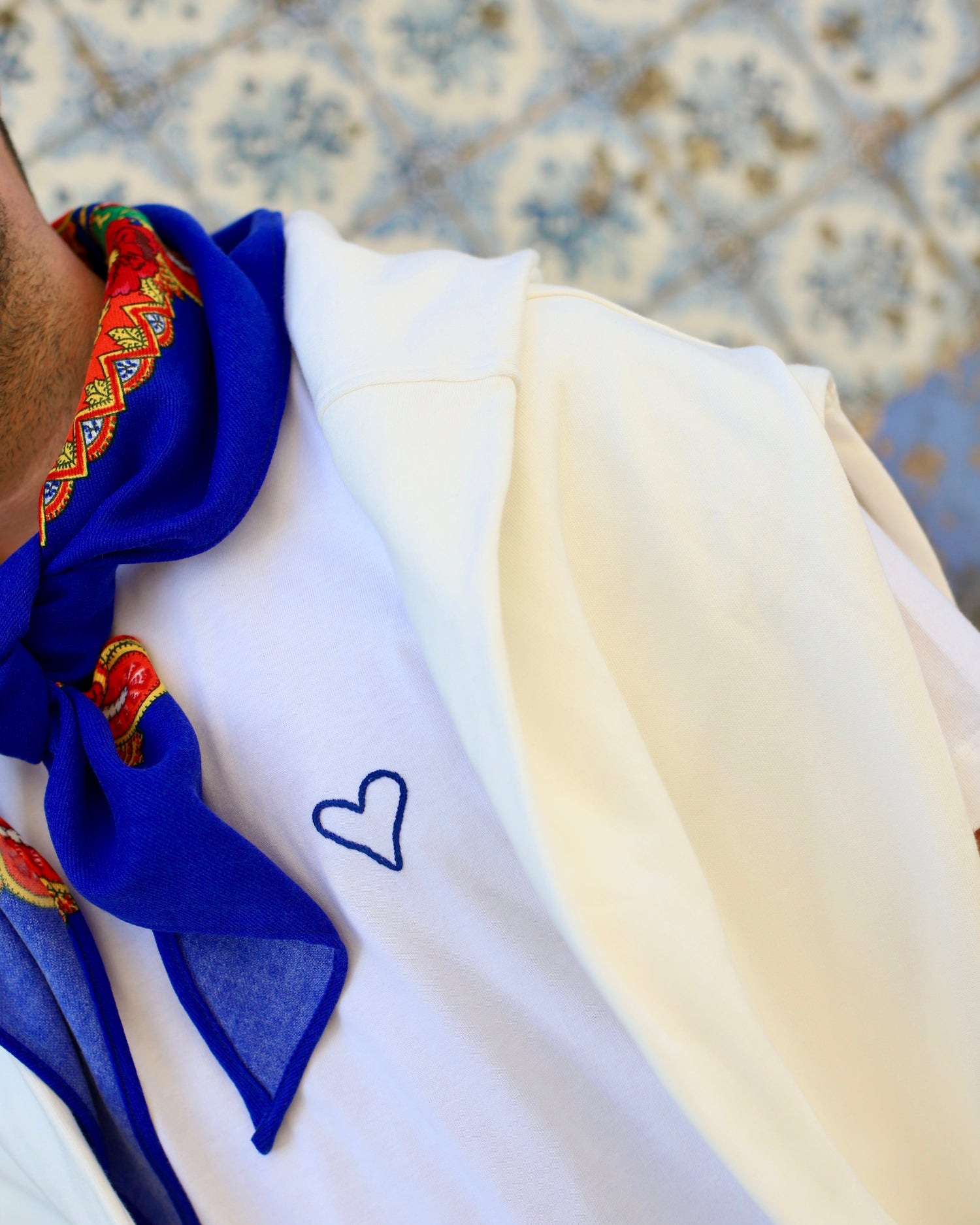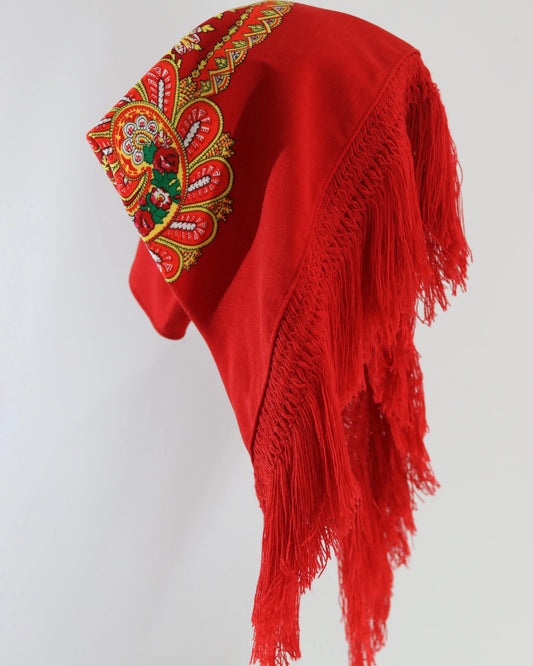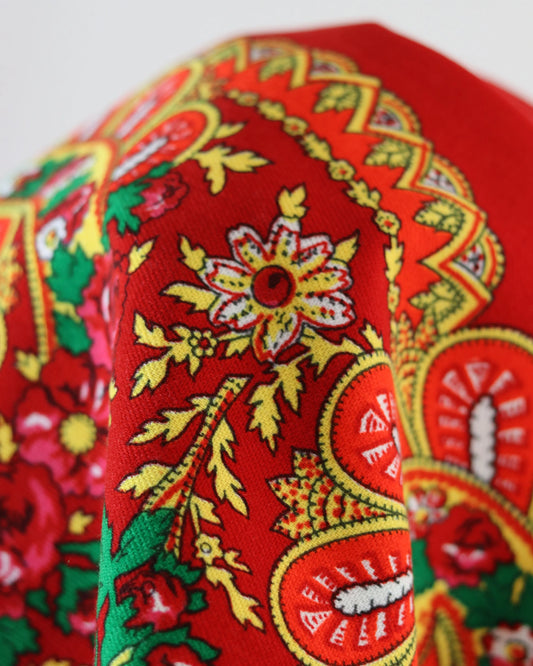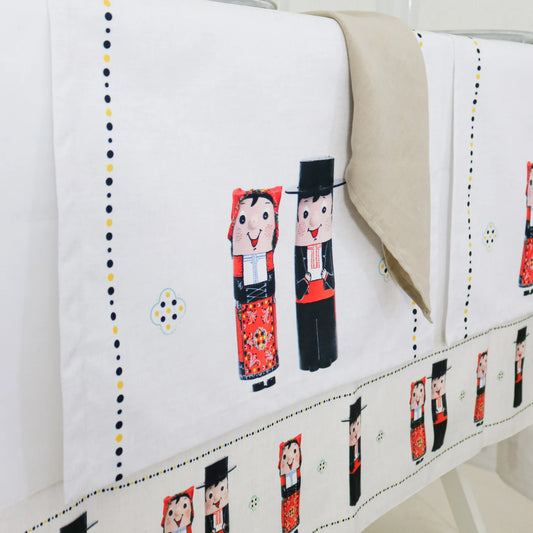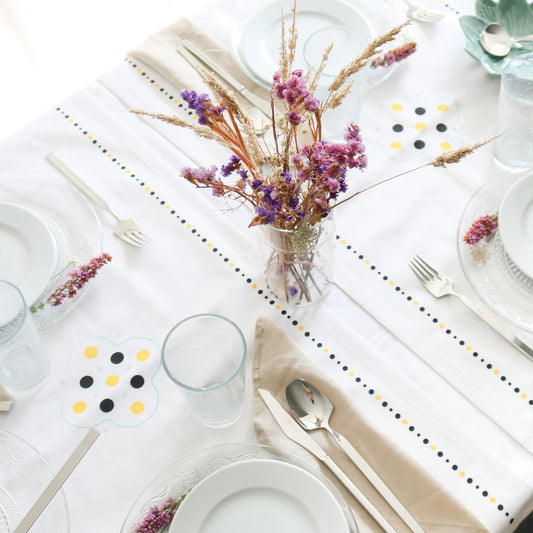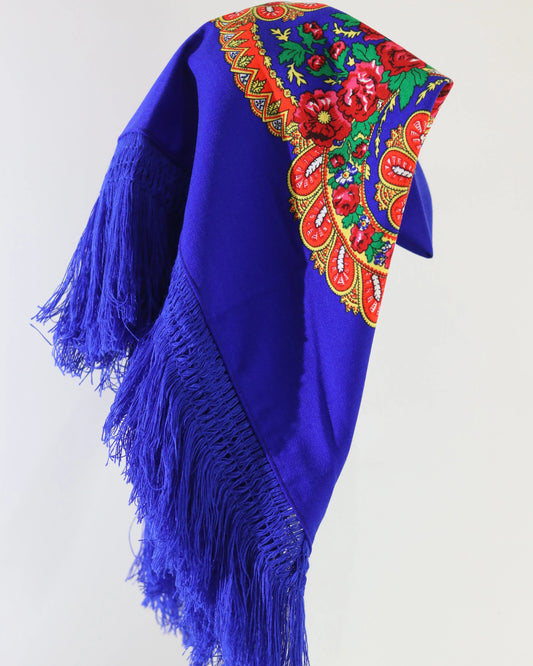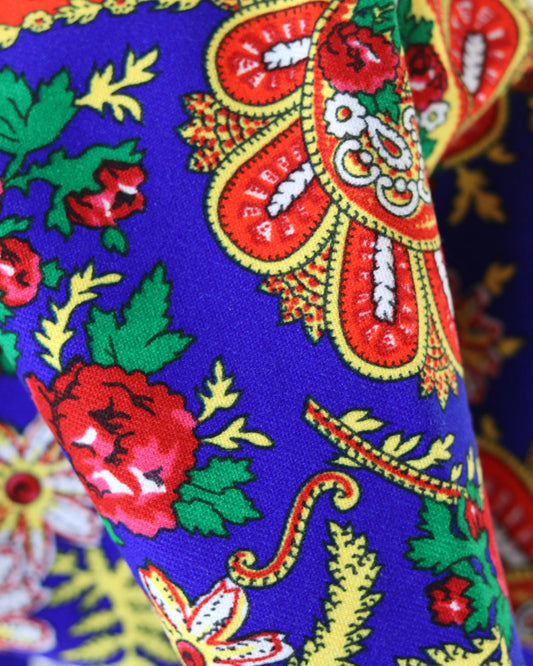History of Viana scarves and their traditions
In the heart of August, when Viana do Castelo vibrates to the sound of bass drums and bagpipes , a sea of colors ripples over full skirts and lace aprons. It's the scarves, with their long fringes, bright reds or luminous yellows, that give movement to the outfit and bring back to the city a memory that is both visual and emotional. Some consider them the finishing touch to a perfect ensemble; others speak of them as if they were open letters, filled with embroidered messages.
The truth is that Viana's scarves hold intertwined stories of women, ports and fairs, fashion and devotion. And the more you look, the more layers reveal themselves.
First appearances and the change of materials
In the 19th century, scarves became a staple in the wardrobes of Alto Minho farmworkers. By the mid-19th century, reports indicate the presence of headscarves, exuberant in color and presence, as part of everyday and festive attire. At that time, Brazilian cotton predominated, especially printed calico fabrics produced by factories like the one in Alcobaça. Some motifs, but measured, were embroidered, and practice indicated a common use: one scarf on the head, another on the chest, both finished with fringes that swayed as they walked.
From the 1870s onward, history accelerated. Minas Gerais markets began receiving fine wool scarves imported from European industrial centers. The new fabrics featured rich prints, dense fringes, and saturated colors. The piece transformed: from a practical accessory, it became a protagonist, especially on festive days. Local tastes embraced this novelty with enthusiasm, and soon, imported scarves supplanted domestic versions as the village decorated itself.
Trade, port and European influences
Viana do Castelo lived by and for the sea. The port, which served exports and supplied fairs, was a bridge for the arrival of fabrics and prints from far away. Among the notable suppliers is the Russian factory of Pavlovo Posad, operating since the 18th century, whose production reached Minho at the turn of the century. This influence was no accident: its wool scarves, soft to the touch and intricately printed, perfectly fit into the festive imagery of Viana do Castelo.
This economic crossover helps explain a curious paradox: practically every Viana costume was crafted from regional hands and crafts, except, for many decades, the fringed scarf. This became the only systematically imported element of the ensemble. This singularity reinforces the scarf's place as a sign of Viana's openness to the winds of commerce and European fashions, without losing the local flavor of its wear.
From everyday life to partying: how style took center stage
The change in material was accompanied by an aesthetic leap. More modest calico scarves gave way to luxurious woolen fringes, with large flowers, sinuous leaves, and cornucopias. Crochet trim gained more prominence, fringes became longer, and the overall outfit adjusted to give the scarf a platform. Fiery red, canary yellow, lake blues, and marsh greens began to compose a palette that was quickly recognized at the pilgrimages.
In the 20th century, folk groups and the promotion of the costume in processions and festivals reinforced its ceremonial use. There were periods of standardization and official classification, especially from the 1930s onward, which consolidated repertoires of colors, cuts, and combinations. At the end of the century, textile industrialization, with cheaper synthetic fibers, spread replicas. The reaction, in the new millennium, brought a conscious return to quality: wool, silk, historical prints, and editions that respect archives, alongside certified local embroidery .
What the motifs say: flowers, cornucopias and hearts
There's a recurring iconography, and not by chance. Floral motifs symbolize fertility, rural beauty, and the cycle of the seasons. Branches, brambles, stems, and leaves anchor the fabric in the countryside, as if the scarf were transporting nature to the celebration. The cornucopias, associated with abundance, echo another characteristic of Viana: gold , which is generously displayed in the mordomas.
- Hearts : They speak of bonds, promises, and fidelity. On certain wedding handkerchiefs, they appear accompanied by verses and names.
- Birds, especially doves: domestic peace and purity of intention.
- Geometric motifs: wheels, “lion’s mouth” contours, finishes that balance the compositions.
There is no single, universal standard. There are families of designs and palettes, and a collective memory that associates colors with neighborhoods, sensibilities, and circumstances.
Occasions of use: pilgrimages, stewardships, courtship and mourning
The grand stage is the Pilgrimage of Our Lady of Agony in August . There, the procession of the stewards offers a complete portrayal of the festive attire, with a love scarf over their shoulders, a candle in their hands, and gold on their chests. In the processions , the cadence of their gait and dances makes the fringes vibrate, multiplying the visual effect.
Some uses are marked by sentiment. On lovers' handkerchiefs, embroidered in linen or cotton, young women engraved love verses and signs of simple, direct content. The offering served as a declaration. Conversely, the attire of a mourner called for sobriety: dark handkerchiefs, deep blue or purple, told the neighbor and the community what was otherwise kept secret.
In everyday life, the scarf served as protection and distinction, practical at work, and elegant at Mass. This flexibility explains its success over so many decades.
A heritage that is learned at home: transmission and workshops
For generations, the mud of the gardens, the living room with the linen chest, and the low-simmering kitchen were improvised classrooms. Mothers and daughters experimented with stitches, chose colors, and honed their embroidery skills. The transmission of knowledge occurred through observation and repetition, with the help of neighbors.
Over time, associations and schools, municipal workshops, and museums that documented processes and taught techniques came together. The result is a fertile balance: intimate practice survives, along with a training network that ensures continuity and renewal. At festivals, folklore group rehearsals function as a living laboratory. Those who attend learn how to dress, how to pin their scarves, how to cross them over their chests, and how to care for their fringes.
From the ballrooms to the stages: folklore, ranches and museums
Popular culture gave scarves a permanent stage. Ranchos de lavradeiras became ambassadors of this aesthetic, presenting the full costume in dances where the scarf is part of the gesture. The movement expanded in the 20th century, during which ethnographic processions institutionalized the image of the costume and made the scarf a recognized symbol in the country.
The Viana do Castelo Costume Museum, opened in 1997, harnessed this energy. In its rooms, visitors find original pieces, interpretive lines, and activities that bring the public closer to the production processes, social context, and variety of uses. Thematic exhibitions, often dedicated to rituals from courtship to marriage, have highlighted scarves as objects of affection and belonging.
Timeline of Viana's scarves
| Period | Materials and techniques | Notes |
|---|---|---|
| Until ~1870 | Cotton chintz; simple embroidery; discreet fringes | National production. Daily and festive use in the villages of Lima |
| 1870–1900 | Fine imported wools; rich prints; dense fringes | Massive influx of foreign scarves; triumph at the festivals |
| 1917 | Embroidery exhibition in Viana | Boosting artisanal production and embroiderers' lace |
| 1930–1960 | Costumes worn in processions; presentation rules | Identity affirmation; repertoires are consolidated |
| End of the 20th century | Affordable synthetics; cultural tourism | Risk of standardization and loss of quality |
| 2005–present | Certifications; historical reissues; wool and silk | “Viana do Castelo Embroidery” stamp and costume specifications booklet |
Certification, rules and who keeps them
The effort to safeguard authenticity translates into concrete measures. Viana embroidery has a protected geographical indication, with rules defining materials, stitches, and finishes. Certified artisans maintain quality standards and gain visibility. Later, the costume specifications established guidelines on colors, composition, and usage instructions, including references for matching scarves.
Museums, city halls, and cooperatives work in networks: they document, train new embroiderers, collect testimonies, and preserve collections. But this isn't about crystallizing an object. The idea is to ensure permanence without erasing diversity, allowing the practice to breathe and engage with the present.
Challenges of the present: tourism, market and authenticity
Visitor interest brought vitality and demand. Alongside, mass-produced versions emerged, using synthetic materials, often with generic designs and simplified fringes. Popularity helps spread the image, but carries the risk of confusing the eye and devaluing the handmade craft.
An effective response has been the faithful reissue of historical models in wool and silk, produced in small series by specialized workshops, and educating the public about the difference between a quality fringed item and a merely decorative example. Another line of action involves showcasing the true variety: there are many legitimate patterns, more than the few "classics" that have become catalog icons.
Public education, with open workshops and live demonstrations, also transforms purchasing into an experience, bringing visitors closer to the history behind the fabric.
How to recognize quality in a fringed scarf
- Feel and drape: Fine wool or silk have body and flow. Acrylic tends to be stiffer or have a plastic sheen.
- Printing: clear contours, no color bleeding, evidence of careful printing.
- Fringes: dense, regular, sometimes finished by hand or with well-executed crochet.
- Palette: bright, deep colors, with harmony between the background and floral motifs.
- Size: generous enough to cover the head or chest with good clearance, without excess shapeless fabric.
- Origin: clear label, identified workshop, certificate when applicable.
Helpful tip: When spreading the scarf out on a flat surface, check the symmetry of the design and the alignment of the fringes. Gross flaws are more common in rushed productions.
Care and maintenance
- Air out after each use, away from direct sunlight.
- Dry clean for wool and silk; for cotton, gentle hand wash, do not wring.
- Store folded in tissue paper, fringes aligned, inside a breathable textile bag.
- Avoid hanging by the bangs. When brushing, use a soft brush and use gentle movements.
- At outdoor events, be careful with smoke and grease. Small stains should be treated immediately.
Small gestures can extend the life of a scarf by decades, and antique pieces deserve an annual inspection to prevent wear and tear.
A brief itinerary for those who want to see and learn in Viana
- Viana do Castelo Costume Museum: collection, temporary exhibitions and workshops.
- Pilgrimage of Our Lady of Agony : parades of stewards , processions and dances that showcase the costume in a live context.
- Certified craft shops and studios: dialogue with embroiderers and the possibility of ordering pieces.
- Municipal educational programs: sessions on embroidery and traditional clothing throughout the year.
- Performances by folk groups: opportunity to observe costume assembly and choreographic use of the scarf.
One piece, many voices
Viana's scarves are a meeting point for embroidering hands, routes that bring fabrics from afar, and festivals that draw the entire city. They hold memories of love written in verse, of discreet mourning, of broods of flowers woven in wool. At the same time, they point to a future that respects ancient gestures and invests in quality and expertise.
To see them dance in the wind of processions , rise on the shoulders of stewards, or rest in grandmother's chest is to understand how a square of fabric can speak for an entire community. And how, with care and intention, it will continue to do so.



